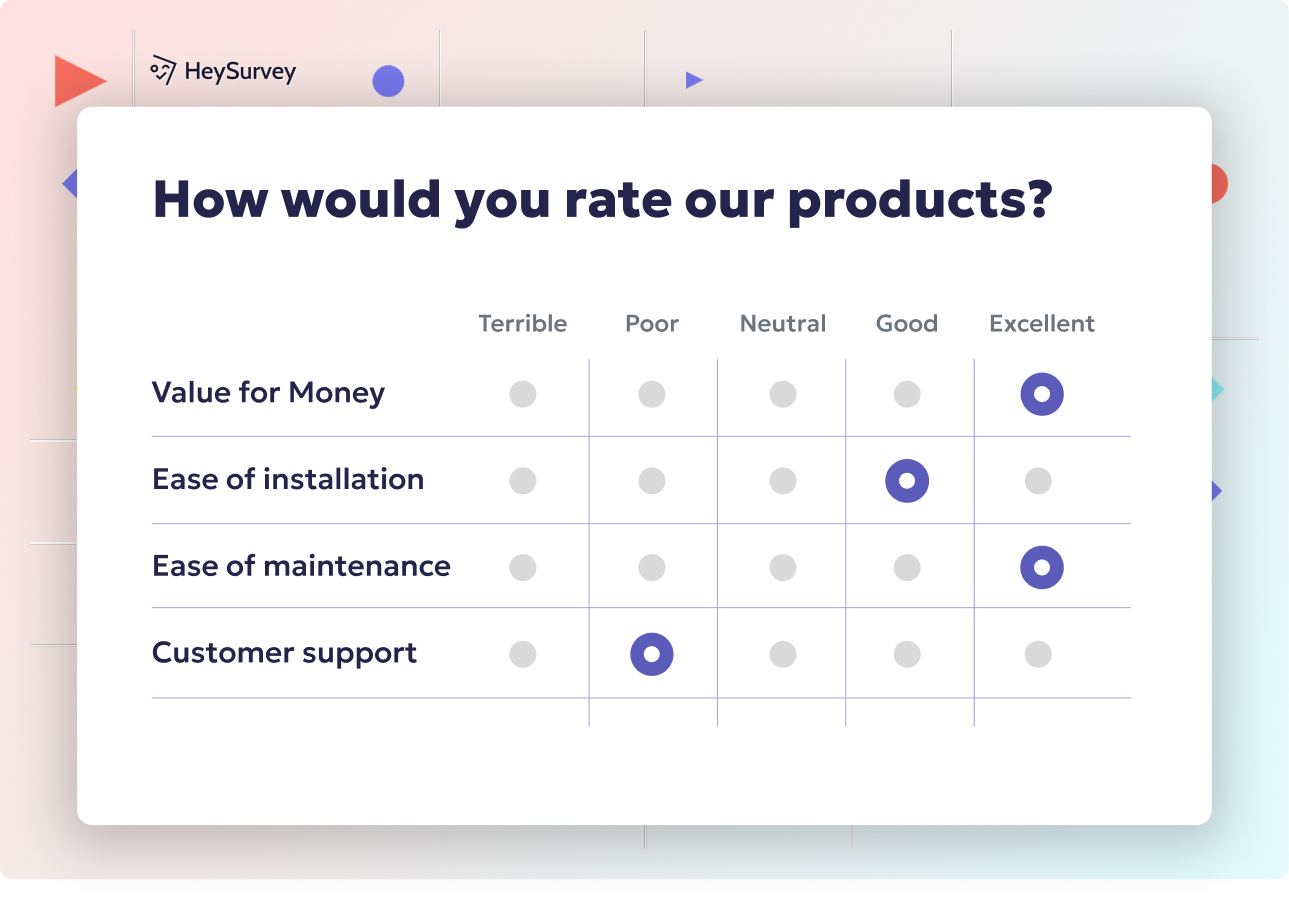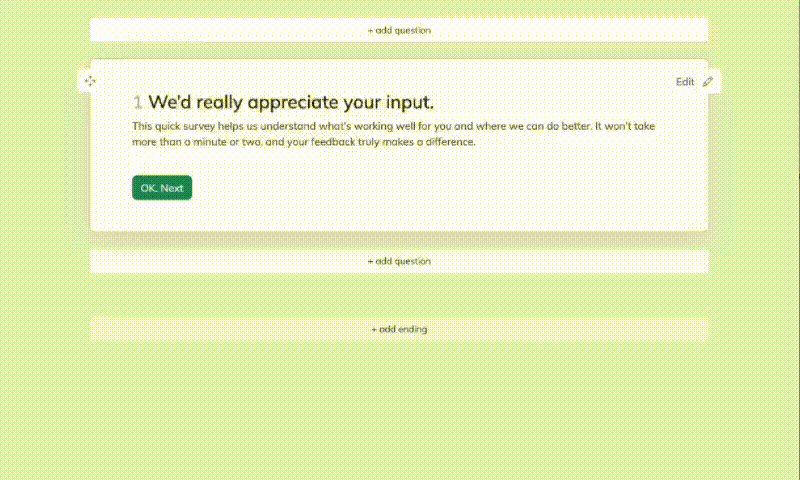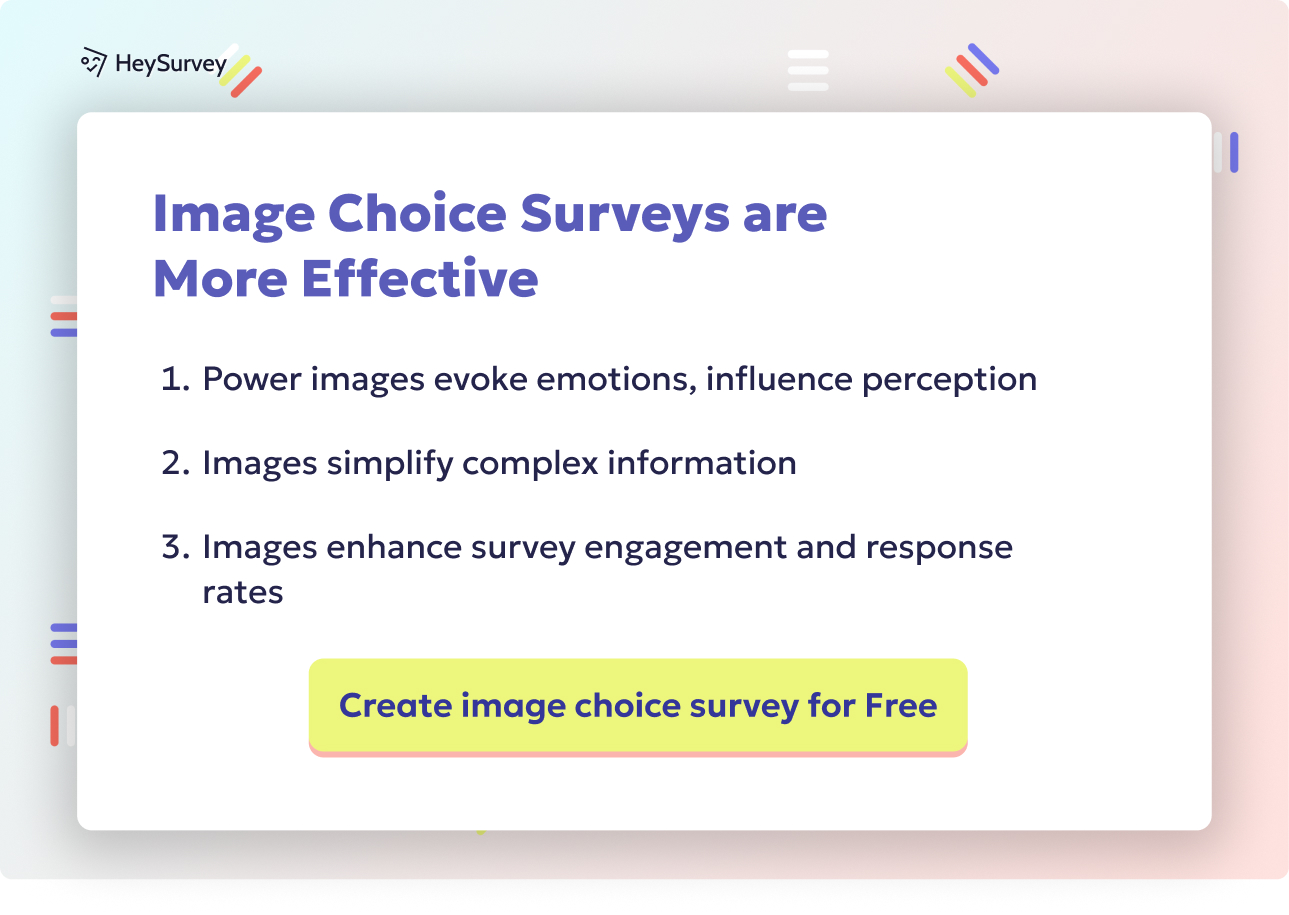32 Tips on What Is the Purpose of Survey Questions Explained
Discover what is the purpose of survey questions with 35 sample questions across 8 types to boost insight and improve survey accuracy.
You might think writing survey questions is just a box-ticking exercise. Think again! The purpose of survey questions is like the secret sauce that takes a bland list of queries and transforms them into powerful tools for insight. When each question is shaped with clarity and intention, you don’t just get answers—you get reliable data, higher response rates, and decision-making confidence. In this guide, you’ll discover the eight most popular survey question types, why and when to use each, and how to craft questions you can copy and paste instantly. Ready to become a data-whisperer? Let’s illuminate the world of purposeful survey questions and dramatically improve your survey accuracy with every response.
Multiple-Choice Questions (MCQs)
What Are Multiple-Choice Questions?
Multiple-choice questions (MCQs) are the bread and butter of structured data collection. These are questions that present respondents with a list of predetermined options, making it easy to select one (or sometimes more) answers. The beauty of MCQs is in their efficiency. They help you slice and dice data quickly because each response already fits a category.
Providing structured choices boosts improving survey accuracy. It’s hard to misinterpret when you click a button instead of filling a blank. MCQs keep your survey tidy and under control—think of them as organizational superheroes, swooping in to wrestle chaos into order.
Why & When to Use MCQs
Wondering when to use specific survey questions like MCQs? They shine whenever you need:
Quick quantification, such as demographics or purchasing habits.
Fast, easy analytics—just add up the clicks!
Categorical options (age groups, favorite products, etc.).
Exhaustion avoidance: plenty of options, but not too many.
Standardization for comparison across groups or time.
They’re ideal for audience profiling, product research, website behavior, and more. If it needs to be counted, start with MCQs.
Five Sample Questions
Which of the following best describes your primary reason for visiting our website today?
What device are you using to complete this survey?
Which feature influenced your purchase decision the most?
How often do you shop online for groceries?
What is your current employment status?
Survey questions are designed to collect specific data, enabling researchers to understand respondents' opinions, behaviors, and demographics, thereby informing decision-making processes. (alchemer.com)

Creating your first survey with HeySurvey is easier than you might think. Follow these 3 simple steps to get your insightful survey up and running in no time!
Step 1: Create a New Survey
- Head to the HeySurvey dashboard and click “Create New Survey.”
- Choose how you want to start: pick a pre-built template to save time or select a blank survey for full customization.
- Give your survey an internal name so you can recognize it easily later.
Bonus: If you want to hit the ground running, click the button below this guide to open a ready-made template perfectly suited for your survey type!
Step 2: Add Your Questions
- Use the “Add Question” button at the top or between existing questions.
- Pick the question type you want (Multiple-choice, Likert scale, Open-ended, etc.).
- Enter the question text, add descriptions if needed, and tweak settings like making a question required or adding images.
- Keep adding questions until your survey covers all the insights you want.
Bonus: Use the branching feature to send respondents down different paths based on their answers—personalize the survey experience automatically!
Step 3: Publish Your Survey
- When your questions look good, click the “Preview” button to check how it appears on desktop and mobile devices.
- Adjust look and feel in the Designer Sidebar: customize colors, fonts, background, and animations to match your brand.
- Once happy, hit the “Publish” button. You can now share your survey link or embed it on your website.
Bonus: Head over to the Settings panel to:
- Add your logo for consistent branding.
- Set start/end dates or response limits.
- Define redirect URLs or allow respondents to view results.
Follow these easy steps, and you’ll be collecting meaningful data quickly with HeySurvey!
Likert Scale Questions
What Are Likert Scale Questions?
When you want to measure attitudes, Likert scale questions are your go-to. These questions use a 5- or 7-point scale—like “Strongly Disagree” to “Strongly Agree”—to see how people really feel. Think of it as emotion on a spectrum.
Likert scales capture sentiment and satisfaction in a way that’s easy to graph. You’re not just counting; you’re mapping feelings. The magic here is nuance—capturing the gray area between “yes” and “no.”
Why & When to Use Likert Scales
Use Likert scales to:
Track satisfaction over time or after changes.
Benchmark group attitudes or compare subgroups.
Segment by sentiment for targeted follow-ups.
Quantify feelings toward multiple experiences.
Spot outliers who are delighted—or disgruntled.
These scales are champions in customer feedback surveys, employee engagement polls, and market research studies. The data is easy to chart, and trends practically leap off the page.
Five Sample Questions
How strongly do you agree that our mobile app is easy to navigate?
Rate your satisfaction with our customer service response time.
How confident are you in the accuracy of the information on our website?
How likely are you to continue using our product in the next six months?
How well does the product meet your expectations regarding durability?
Effective survey questions are clear, concise, and tailored to the target audience to ensure accurate and reliable responses. (pewresearch.org)
Open-Ended Questions
What Are Open-Ended Questions?
When you’re hunting for depth, open-ended questions are the treasure maps of survey design. Instead of picking an option, respondents type in their own words. This unlocks stories, suggestions, and surprises.
You’ll uncover those “unknown unknowns”—the stuff you didn’t even think to ask about. Qualitative depth brings out what’s hiding between the numbers and lets your respondents vent, praise, or imagine freely.
Why & When to Use Open-Ended Questions
Open-ended questions are a must when:
Digging into motivations and first-hand experiences.
Seeking verbatim testimonials for marketing.
Diagnosing mysteries or pain points customers encounter.
Exploring uncharted territory in new markets.
Wanting candid, nuanced feedback that options can’t capture.
Use them sparingly, as they demand more effort from respondents. But when you need richness, nothing beats “tell me more.”
Five Sample Questions
What motivated you to choose our brand over competitors?
Describe one improvement you’d like to see in our product.
Tell us about your most memorable experience with our support team.
In your own words, how does our service add value to your daily routine?
What other products would you like us to offer in the future?
Semantic Differential Questions
What Are Semantic Differential Questions?
Ever feel stuck between two extremes? Semantic differential questions make that tension visible. Respondents rate something on a scale anchored by two opposite adjectives—like “Unattractive” and “Attractive.”
This technique is gold for revealing nuanced perceptions about your brand, product, or service. Semantic differences go deeper than “good” or “bad”—they map out emotional tone and unique positioning.
Why & When to Use Semantic Differential Questions
Reach for this question type if you need to:
Visualize brand positioning against rivals.
Pinpoint perception gaps (e.g., friendly vs. formal).
Track brand identity over time.
Sense subtle shifts in user attitudes.
Compare how segments view the same experience.
They work wonders in brand tracking, advertising development, and user experience research.
Five Sample Questions
Rate our website on a scale from Unattractive ___ ___ ___ ___ ___ Attractive.
How do you perceive our brand: Traditional ___ ___ ___ ___ ___ Innovative?
Evaluate our customer support: Unhelpful ___ ___ ___ ___ ___ Helpful.
Assess product pricing: Expensive ___ ___ ___ ___ ___ Affordable.
How is our delivery speed: Slow ___ ___ ___ ___ ___ Fast?
Semantic differential scales effectively measure attitudes by capturing nuanced perceptions across evaluation, potency, and activity dimensions. (simplypsychology.org)
Ranking Questions
What Are Ranking Questions?
Sometimes you don’t want a popularity contest—you want a real pecking order. Ranking questions force respondents to arrange a list of items in order of preference, importance, or relevance.
These questions unearth priority and trade-off insights you just can’t get by asking for a single “favorite.” You see precisely what comes first, last, and in between.
Why & When to Use Ranking Questions
Deploy ranking when you need:
Feature road mapping based on true priorities.
To optimize menus, bundles, or product lines.
Decisions about message hierarchy in targeted marketing.
Evidence of what influences people most… and least.
Competitive insights into what climbs (or falls) in customer priority.
They’re invaluable for product management, event planning, and optimizing communication strategies.
Five Sample Questions
Rank the following product features from most to least important.
Order these communication channels by your preferred method for receiving updates.
Prioritize the following benefits when choosing a fitness app.
Arrange these factors in order of influence on your buying decision.
Rank upcoming webinar topics you’d most like us to cover.
Demographic Questions
What Are Demographic Questions?
To truly enable segmentation and profiling, demographic questions gather key background info about your respondents. This might cover age, location, education, income, and more.
These questions are like the “index cards” of data—they help slice your audience into meaningful subgroups and power customized strategies. Demographic details also ensure your findings make sense in context.
Why & When to Use Demographic Questions
You’ll need these questions if you want to:
Target communications or products to the right people.
Cross-tabulate responses and spot cool patterns in your data.
Satisfy compliance reporting (for grants, research, legal stuff).
Benchmark your customer base against market norms.
Understand who is loving—or leaving—your offering.
Demographics unlock a world of smart segmentation and sharper decision-making.
Five Sample Questions
What is your age range?
Which region or state do you currently reside in?
What is the highest level of education you have completed?
Which of the following best describes your household income bracket?
What is your marital status?
Net Promoter Score (NPS) Question
What Is a Net Promoter Score (NPS) Question?
Think of the Net Promoter Score (NPS) as the world’s most compact loyalty detector. One simple item: “On a scale of 0–10, how likely are you to recommend us?” NPS divides respondents into Detractors, Passives, and Promoters.
This question packs a powerful punch. It simplifies benchmarking loyalty and predicting growth with a single data point and only takes seconds to answer.
Why & When to Use NPS
NPS is your bestie if you want to:
Track advocacy and word-of-mouth potential.
Identify promoters for testimonials or referrals.
Flag detractors for proactive follow-up.
Monitor loyalty before/after product changes.
Fuel growth strategy with a proven metric for comparison.
Use it in customer satisfaction programs, after events, or as a regular pulse check.
Five Sample Questions
On a scale of 0–10, how likely are you to recommend our company to a friend?
How likely are you to recommend Product X to a colleague?
Based on your recent support experience, how likely are you to recommend our service?
After today’s webinar, how likely are you to recommend it to peers?
Considering our new pricing plan, how likely are you to recommend us?
Best Practices: Dos and Don’ts for Purpose-Driven Survey Questions
Dos
Creating stellar surveys means getting intentional. The survey question best practices below help you boost clarity, insight, and trust.
Keep wording neutral—never steer answers.
Align each question to a clear KPI or business goal.
Randomize answer options if order bias could sneak in.
Pre-test the survey for clarity and timing.
Limit survey length to avoid abandonment or “speeding.”
Don’ts
Even the best surveys get tripped up by rookie mistakes. Avoid these don’ts to keep your data golden and your respondents smiling.
Don’t use double-barreled questions (asking two things at once).
Don’t pepper in jargon or mysterious acronyms.
Don’t ask for sensitive data unless you have a compelling reason.
Don’t force people into mandatory essay questions.
Don’t use leading phrases (“Don’t you agree that…?”—we see you!).
Quick Checklist
Every question has a specific purpose.
Easy, accessible language for all.
Answer choices are mutually exclusive (and exhaustive when possible).
Privacy respected—highlight GDPR, CCPA, and other relevant regulations.
Each survey offers a clear opt-out or confidentiality notice.
How to write effective survey questions isn’t rocket science…but it’s a craft!
Remember: great surveys are concise, respectful, and designed for insight. You’ll win loyalty and wisdom by making every question count—both for you and your respondents.
Curiosity and purpose make every survey a little adventure. With these question types and best practices, you’re ready to craft questionnaires that deliver real insights and delight your audience. Great questions don’t just gather answers—they spark action, innovation, and trust. Stay intentional, keep it clear, and survey on!
Related Question Design Surveys

29 Quantitative Survey Research Questions Example for Success
Explore 25+ quantitative survey research questions example with clear explanations and tips for c...

32 Good Survey Question to Boost Your Data Quality
Discover how to craft good survey questions with 30 sample questions across 8 types for better da...

31 Survey Question Mistakes You Need to Avoid Today
Discover 25 common survey questions mistakes with real examples and expert tips to craft clear, u...